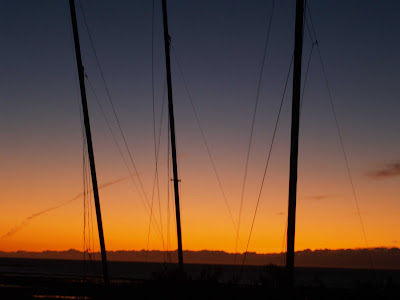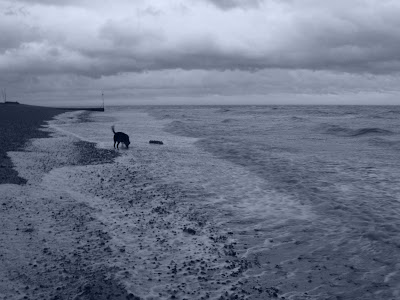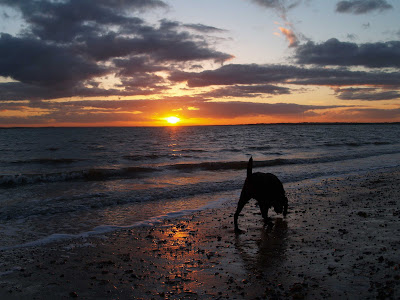Sing this corrosion to me.
Monthly Archives: January 2007
TBTM20070119
Windy

Windy walk this afternoon (see here for context). I thought I’d do a subdued piccie, as there will doubtless be lots of dramatic ones. Normally, after the tide has been in, the beach is completely smooth. This is what the wind does on a small scale.
TBTM20070118
The colour of my shirt
In the last year of my time at Westcott my training incumbent came to visit. In the middle of a good conversation we began to talk about shirt colour, as I was soon to invest in purchasing the clerical necessaries. I asked if it was possible to have a different colour than black – thinking principally of dark blue (which is what I now wear). With his customary grace my incumbent indicated gently that black was the only acceptable option…
The apparel of a bishop, priest, or deacon shall be suitable to his office; and, save for purposes of recreation and other justifiable reasons, shall be such as to be a sign and mark of his holy calling and ministry as well to others as to those committed to his spiritual charge. (Canon C27)
I attended a boarding school for seven years, from the age of eleven (this one). At one point I acquired a temporary nickname, ‘Jimmy’, due to a distinct facial resemblance to Jimmy Somerville.
This I did not appreciate, for Jimmy was gay, and within a boys boarding school, being gay was anathema.
There was one friend at the time who was a little odd, who didn’t quite fit in with the prevalent macho culture. The boys who were esteemed were the ones who displayed great biological prowess – on the sports field, through dominating a social hierarchy, or sexually. To be a ‘stud’ gave instant social kudos. Reflecting on that now I can see that mimetic rivalry was rampant.
My friend wasn’t very good at any of that, though he did have quite a waspish tongue, which helped. Sometimes. We victimised him in the way that boys do, with cruel ritual humiliations.
At Lambeth in 1998 the gathered stewards of our great mysteries came together and proclaimed a policy (full text here).
There were two aspects to this policy: first a recommitment to the traditional rejection of homosexuality; second, a commitment to listen to homosexuals. I have taken the second of these quite seriously – indeed, I had taken it seriously for quite some time before that conference. The church I attended in the 1990s (this one) was very gay-friendly (occasionally it was described as a ‘gay ghetto’!); I learned an awful lot there, and got to know a lot of gay people, both lay and clerical.
Every so often in the 1990’s, particularly when I was single, I would spend time wandering in Soho. I used to think of it as my ‘fugue state’. I would just wander around, spend time in the bookshops on Charing Cross Road, occasionally going into the cafes, going to the cinema a lot. It was a place where I could forget who I was for a while.
Soho was (obviously) very ‘gay’ – but not just in the homosexual sense. It was colourful and vibrant. I think the loss of the original meaning of the word ‘gay’ reflects a loss of a certain form of masculinity; and that men have suffered from that loss. There is a strong strand of male nature that is now repressed, for precisely the reasons that were dominant at my boarding school.
The repressed returns in various ways. Look at the way that footballers celebrate when they score.
Our communion has lost its way with regard to sexuality; hence the present crisis. We struggle with the legacies received from previous generations, from previous patterns of value. It is quite possible that this is the prelude to a creative resolution. I hope so.
The church has to be a gay church; otherwise it is failing to be a church.
Disordered sexuality is not an abstract concept for me; it is something with which I am intimately familiar. Yet God is never absent.
In the mid 1990s I had a painful split with a girlfriend, about whom I was rather serious. In the ensuing months I had a great deal of rage and jealousy running through me which – because I lacked the self-awareness to deal with such things at that time – led me into some very dark places, and some very damaging behaviour.
After one episode – an episode that, had it been recounted at school, would have led to a significant increase in my social standing, and have established me as a ‘real lad’ – God took a hand.
I have never been so terrified in my life.
It was made indisputably clear to me that I was rapidly walking down the path to hell, which was not a metaphor but something concretely real; that my life choices were destructive, both of myself and of others; and yet, in the midst of being convicted of my depravity and sin, God gave me a vision. Of presiding at the altar; of being ordained.
I did not welcome this. I resisted.
What could be less likely work for a ‘real lad’? Priesthood was for poofs.
One deeply attractive aspect of present day gay culture – and one that is most authentically Christian – is that it is, on the whole, a place of non-judgement, particularly with regard to sexual disorders. I imagine that a community which lives each day with the shout of condemnation from the worldly powers has learnt to be frugal with its own condemnation.
I met up with my school friend at this time. He had recently come out as a gay man, and we went for a drink in a bar just up from Leicester Square tube station.
I said sorry for the things I had done at school. He said he forgave me.
One of the most memorable sermons I heard at school – we had services every day, sermons twice a week – was by a minister who brought in a stereo, and played the Pet Shop Boys’ ‘It’s a Sin’ to us. He was insistent that Christianity was misunderstood. It wasn’t about being negative, about repressing all of our instincts, and telling us that everything that we enjoyed was bad for us. Christianity was about embracing a fullness of life, that allowed us to be all that we can be.
Allowing us to become who we are.
For we are each loved by God, and we each have a vocation from Him.
At school – and strongly reinforced by the surrounding culture – boys are taught to ogle. This is the lust of the eyes. Boys in a boarding school have various ways in which to pass on this mimesis, out of the sight of disapproving housemasters. One friend in particular took great delight in his poster of a topless Linda Lusardi hidden on the back of his door, almost never seen by the staff.
I read Playboy for many years after leaving school. And despite your incredulous laughter, I do mean read, not just gaze at bare breasts. Pornography is very damaging; the damage it causes is hugely underrated. The problem is not the nudity, which is (can be) something holy. The problem is in the destruction of genuine intimacy, the abolition of relationship, and the stimulation of an appetite which is then not fed.
Bad love can only be redeemed by good love.
I resisted my vocation for two days and two sleepless nights. On the third day, at lunchtime, I went to my church, and knelt down, and accepted God’s will for me – but even then I said ‘please don’t make me celibate!’
Although accepting the vocation gave me a great sense of peace, and a significant feeling of slipping my bindings, it takes a long time to grow into a vocation. God is patient; it’s an aspect of his mercy.
I left my job at the Civil Service and worked for a year as a caretaker, in the primary school attached to my church. One of my regular tasks was clearing up after the ‘accidents’ left by the children – either the vomit or the excrement left in unwelcome places.
I got quite good at this. I had a distinct system: plastic bag; paper to mop up the major part of the mess (to be placed in the plastic bag); mop and bucket to clean the floor afterwards; disinfectant. On a good day I could clear up a site in less than five minutes.
I never got angry with the children for this. What was the point? The children were learning how to conduct themselves, and control themselves. Ranting and raving about the messes being created would only have disfigured their souls.
It’s the same now with changing nappies. You don’t get hung up on the present moment – you preserve the end-point in your heart, and never let go of that sense of where your child is growing. That’s what it means to have parental love.
Of course, God is no different in that respect.
I said that I resisted my vocation; the roots of sexual disorder took longer to deal with. Only two months after this experience I got involved with a girlfriend and, frankly, I was a complete shit. I was in no fit state to embark on a relationship; I made promises I couldn’t keep; I was precisely not strong enough to be her man.
And so, the car crashed.

One lunchtime, I was walking by the Thames, in the park behind the Houses of Parliament. The tide was high, and I watched some leaves float off. It was the one time in my life that I have seriously contemplated suicide.
What prevented me from jumping in was reflecting on a) my vocation, but b) more importantly, the week of silence that I had recently spent in Taize, where I had started to accept my vocation.
I accepted the promise, and the hope, and this was where I really began to believe in a God of grace. We are not saved by our own strength.
I’ll stand before the Lord of song
With nothing on my tongue
But Hallelujah
*Christopher wrote something very interesting the other day, amending Bishop Tutu: “Be nice to the straights, they need you to rediscover their humanity.”
I have found great insight and comfort from listening to the gay community, not least through understanding the Girardian perspective, and reading James Alison. In particular, his ‘Faith Beyond Resentment’ untied many of the knots within which I remained bound. His “The boys in the square” is haunting.
The problem with our communion is a lack of listening, despite Lambeth 1998. For all the criticisms hurled at Rowan, that is something that he has consistently insisted on.
When I was ordained, +Richard placed his hands on me and said ‘Shine as a light in the world Sam’. We are not to hide away in the darkness. We are meant to be bright lights illuminating the world.
Our deepest fear is not that we are inadequate. Our deepest fear is that we are powerful beyond measure. It is our light, not our darkness that most frightens us. Your playing small does not serve the world. There is nothing enlightened about shrinking so that other people won’t feel insecure around you. We are all meant to shine as children do. It’s not just in some of us; it is in everyone. And as we let our own lights shine, we unconsciously give other people permission to do the same. As we are liberated from our own fear, our presence automatically liberates others.
So far as I can tell, to be gay is to shine.
The right ordering of our desire is at the heart of Christian faith, for our hearts remain restless until they rest in God. Once our desires are rightly ordered, then we become the people whom God is calling us to be.
At that point the pressures from society can be progressively withstood and then ignored. We shall be free to become who we are.
I deal my own cards, sometimes the ace, sometimes the deuces.
After my father died, I inherited some rather colourful shirts. Bring out the peacock!

One day, I will have the nerve to wear one of these as my clerical shirt.
One day, churchmen will no longer be afraid of gay men.
Reordering the sanctuary
A discussion paper for West Mersea PCC
Issue
The Rector would like the PCC to consider reordering the sanctuary and chancel area within St Peter and St Paul’s church, principally through moving the altar from its present position at the East End, swapping places with the choir.
Theological context
Jesus said “Destroy this temple, and I will raise it again in three days” (John 2.19). The New Covenant inaugurated in Jesus’ life, death and resurrection involved a replacement of the Temple with Jesus’ own body, most especially the celebration of the Eucharist – “This is my blood of the New Covenant”. This has many aspects, but one key element can be thought of as a replacement of a vertical form of worship with a horizontal one.
The temple was built according to very specific instructions, and a plan looks like this:
Temple worship is hierarchical – there is a steady ascension from the world of the profane to the Holy of Holies, and there is a corresponding stripping away of profane people – first the gentiles, then the women, then the non-priests, then finally only the High Priest is able to enter into the most holy place itself. This is what Jesus overturns.
In contrast to Temple worship, with its vertical hierarchy, the Eucharist is a horizontal form of worship, involving a gathering of the equally profane around a common table, to share in a common meal. Whilst there are still ‘priests’, these are not priests in the Temple sense – they are rather ‘presidents’, those whom the church has called out to a specialised rôle in the worshipping life of the community. So an image of horizontal worship, in this sense, might be this:
Although this is a very basic feature of the New Covenant, it is fair to say that church history records a community which has largely ignored the nature of horizontal worship in favour of the hierarchical model. Hence the prevalence in churches of an altar at the East End. A reaction against this began with the Reformers, who sometimes brought the altar down into the nave itself, but beginning with Vatican II, there is now a substantial ecumenical consensus in favour of a more horizontal understanding of eucharistic worship. This can be seen where cathedrals have re-ordered their own sanctuaries. In St Paul’s Cathedral, for example, celebrations of the eucharist now take place beneath the great dome, in the centre of the cathedral, and the choir are behind the altar. This is what I am looking to establish here in West Mersea.
Logistical issues
As well as this fundamental theological point, there are two practical issues which concern me about our present arrangement, one minor, one major. The minor issue is that the president at the altar cannot see the main part of the lady chapel – and cannot be seen by them. That part of our community is therefore prevented from a full participation in what is happening at the Eucharist (‘Behold the Lamb of God’ doesn’t really work where the beholding is impossible). More crucially – and putting it bluntly – the choir get in the way! (This is not the fault of the choir, of course, it is a purely physical point.) I see two main issues – firstly, when people are at the altar rail to receive communion there is a severe bottle-neck on each side of the church as people have to either wait for a group of people to leave the altar rail, or else walk amongst people’s feet; secondly, people have to negotiate their way past the Director of Music as he conducts the choir from his position at the top of the steps. Each of these aspects I see as significant.
Proposal
I therefore propose that we bring the altar forward from its present position, and move the choir to the rear of the church, to look something like this: I see the choir being deployed facing directly West. This maximises the available space, and is acoustically the best option. A number of people have expressed a concern about ‘worshipping the choir’, but that is still applying the vertical model of worship to the arrangement. The whole point is that Christ is ‘in the midst’ of us. At the far East End, between the choir stalls, I see the Bishop’s chair being placed, signifying his role as the ‘ordinary’ of the church (ie the one with ultimate responsibility for our eucharistic worship – the Rector and other clergy operate ‘in his stead’).
I see the choir being deployed facing directly West. This maximises the available space, and is acoustically the best option. A number of people have expressed a concern about ‘worshipping the choir’, but that is still applying the vertical model of worship to the arrangement. The whole point is that Christ is ‘in the midst’ of us. At the far East End, between the choir stalls, I see the Bishop’s chair being placed, signifying his role as the ‘ordinary’ of the church (ie the one with ultimate responsibility for our eucharistic worship – the Rector and other clergy operate ‘in his stead’).
Issues to consider
There are a number of detailed elements which need to be considered, as well as the major principle itself. Amongst others:
– how to distribute communion under the new arrangement;
– how to cater for those who wish to kneel to receive;
– whether to move the crucifix from its present position to one directly above the altar (which would be a powerful visual symbol of the nature of the eucharist itself);
– where to place the Rector’s and curate’s pews;
– whether the new arrangement would work for all services, thinking especially of funerals.
There are doubtless other aspects and details which PCC members may wish to raise.
Timetable
I propose the following timetable:
– firstly, that in its February meeting the PCC agree that this is a suggestion worth exploring, and that we write to the Archdeacon requesting a temporary faculty covering an initial moving of the altar;
– secondly, that we move the altar as soon as possible, and ‘live with’ the arrangements for a period of three months. There will certainly be unforeseen aspects of the change that only become apparent after a change of use;
– thirdly, that we meet for a study day on a Saturday morning in the summer, with the wider congregation, to discuss our experience and to consider whether this is a path that we wish to pursue further;
– fourthly, if we do wish to pursue the rearrangement, that we then formally engage our architect to work up concrete proposals for the PCC to take forward.
(Being distributed to PCC members and ministers today.)








